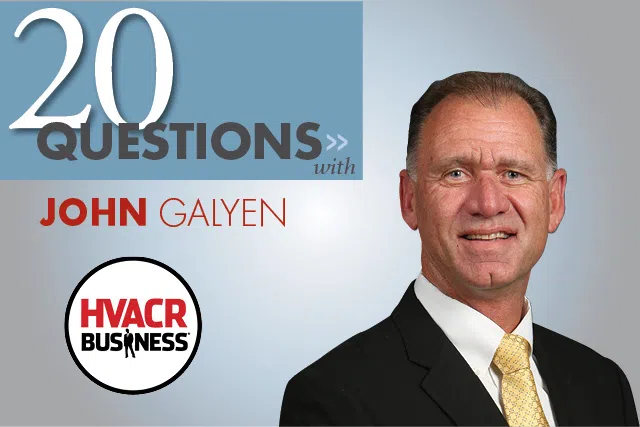Terry Tanker recently caught up with John Galyen, president of Danfoss North America. The two discussed recruiting Millennials, government regulations, holding people accountable and what’s changed in the industry since their last interview in October 2006.
1. It’s been a while since we played golf — how’s your game?
Not too good … I bought a boat!
2. How about some details on that?
It’s a 27-foot Sea Ray. I do enjoy golf, but I like to fish and boating allows me to spend time with my family and friends.
3. How have your responsibilities changed since we sat down 10 years ago?
I now oversee all of the businesses here in North America — our cooling, drives, heating, and power solutions segments. And I’m pleased to say the business has more than tripled over those past 10 years.
4. What’s your favorite aspect of running the business?
It’s shifted since our discussion 10 years ago. Aside from making sure we hit our sales targets, I spend a significant amount of time on talent development — getting the right people in the right spots. I find that rewarding and crucial for the direction of our company.
5. Many trades struggle to find talent — how did this skills gap come about?
I listened to a guest speaker at a board meeting last year, Ken Gronbach. He’s a demographer who proclaims the issue we’re facing right now in getting trade personnel is related to demographics. Baby Boomers, the largest population at 80 million, are retiring. There are only 51 million Gen Xers, but many more Millennials at 75 million. His premise seems compelling: As many as 50 percent of Generation X have a college education with many job choices, so they’re not compelled to join the trades.
6. So we have to look to Millennials to fill the gap?
It would appear so. There simply aren’t enough Gen Xers in the pool and there are going to be huge numbers of Boomers retiring. Seventy-five million Millennials are going to need jobs, so it’s the group we have to recruit and invest.
7. Recruit is the right word, but how?
First, we have to understand what’s important to Millennials — what makes them tick so to speak. It’s really no different than any other segment of the population when you’re trying to win them over whether for jobs, clothes or a can of soda. Understanding your target audience is key.
8. From a contractor’s point of view, how would you focus recruiting efforts?
In general, we need to create broader awareness of our industry and how good a career option it is. It’s incredibly stable and you can make a great living. Contractors have to address the perception of seasonality. Most contractors are busy year-round, especially if they actively sell service contracts. Emergency work could be a liability, however, but a lot of that will change as equipment becomes more digitally connected. Digitally connected systems will make our industry more attractive to the Millennials and will be an important recruiting tool for contractors.
9. Do you think the new administration will be more business friendly?
I hope so. Many of the regulations are tied to energy efficiency and new, low-GWP refrigerants. It’s a big challenge for our industry and it will bring additional complexity and cost to all stakeholders, including manufacturers, distributors, contractors, and consumers.
10. What special projects have you been working on?
We’re making a lot of investments to improve our customers’ experience so it’s easier for them to do business with us. We’re also investing in a state-of-the-art Application Development Center for testing our customers’ chillers and rooftop units as well as advancing our own R&D.
11. Danfoss has won several AHR Expo Innovation Awards for 2017 — can you elaborate on them?
We won in two categories: building automation for our electronically delivered services in the food retail market, and refrigeration category for our CO2 multi-ejector solutions. We also received an honorable mention in the green building category for our Turbocor TG compressor.
12. What’s the best performing business sector for you right now?
Food retail. Specifically, supermarkets.
13. What’s driving that?
Stores are investing. Plus, there is a move towards CO2 refrigerant and distributed controllers. Owners like individual case controls versus a head end or central controller because it provides greater control at the case, better energy efficiency, and a lower total cost.
14. What’s your focus for 2017?
Growing the business across segments, which can be complicated. But this is also a great opportunity. We have customers who today are buying in one area but would also be ideal customers in one of our other segments; however, we may be using a totally different sales team that may not recognize the commonality.
15. What’s your typical month look like?
I spend 50 percent with customers or on association-type activities, and 50 percent in the office. Internationally, I average about one trip every other month to Europe or abroad to meet with my Danfoss peers from around the world.
16. Where would you like to spend more time?
With customers. It’s important for me to stay connected to how we’re performing as a supplier.
17. What’s your forte as a manager?
I like to lead by example and I dislike micromanaging. When we set objectives, my expectation is you will reach the goals we’ve outlined and I will hold you accountable.
18. Holding people accountable can be difficult — how do you do it?
I hold monthly performance meetings and I’m direct. Finding the right person for the job makes my job easier. Coaching can be helpful when it comes to finding someone who may not have the right experience but does have the ideal skill set for the job.
19. What do you tell managers who say they don’t have time for performance meetings?
They’re making a mistake.
20. How so?
Part of your role and responsibility as a manager is to provide guidance and support. This is dependent on each person, his or her role and the situation. Sometimes, you need to use the stripes on your shoulder to get alignment or break down obstacles — that’s your job as a leader and manager.






